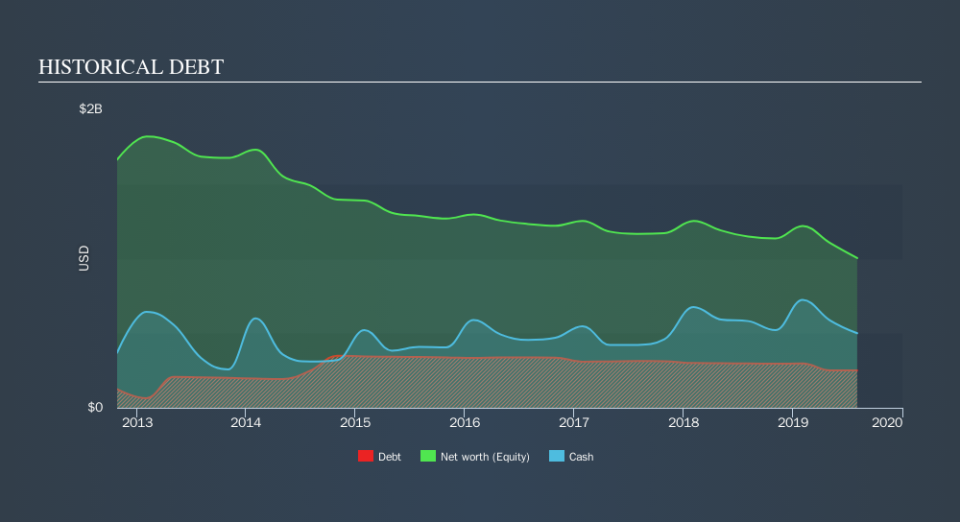These 4 Measures Indicate That Abercrombie & Fitch (NYSE:ANF) Is Using Debt Extensively

Legendary fund manager Li Lu (who Charlie Munger backed) once said, 'The biggest investment risk is not the volatility of prices, but whether you will suffer a permanent loss of capital. So it might be obvious that you need to consider debt, when you think about how risky any given stock is, because too much debt can sink a company. We note that Abercrombie & Fitch Co. (NYSE:ANF) does have debt on its balance sheet. But should shareholders be worried about its use of debt?
When Is Debt A Problem?
Debt is a tool to help businesses grow, but if a business is incapable of paying off its lenders, then it exists at their mercy. If things get really bad, the lenders can take control of the business. However, a more frequent (but still costly) occurrence is where a company must issue shares at bargain-basement prices, permanently diluting shareholders, just to shore up its balance sheet. Of course, the upside of debt is that it often represents cheap capital, especially when it replaces dilution in a company with the ability to reinvest at high rates of return. When we think about a company's use of debt, we first look at cash and debt together.
View our latest analysis for Abercrombie & Fitch
What Is Abercrombie & Fitch's Debt?
As you can see below, Abercrombie & Fitch had US$251.0m of debt at August 2019, down from US$297.1m a year prior. However, its balance sheet shows it holds US$499.8m in cash, so it actually has US$248.7m net cash.
A Look At Abercrombie & Fitch's Liabilities
We can see from the most recent balance sheet that Abercrombie & Fitch had liabilities of US$790.2m falling due within a year, and liabilities of US$1.61b due beyond that. On the other hand, it had cash of US$499.8m and US$98.7m worth of receivables due within a year. So it has liabilities totalling US$1.81b more than its cash and near-term receivables, combined.
This deficit casts a shadow over the US$1.00b company, like a colossus towering over mere mortals. So we'd watch its balance sheet closely, without a doubt After all, Abercrombie & Fitch would likely require a major re-capitalisation if it had to pay its creditors today. Abercrombie & Fitch boasts net cash, so it's fair to say it does not have a heavy debt load, even if it does have very significant liabilities, in total.
But the other side of the story is that Abercrombie & Fitch saw its EBIT decline by 4.4% over the last year. If earnings continue to decline at that rate the company may have increasing difficulty managing its debt load. The balance sheet is clearly the area to focus on when you are analysing debt. But it is future earnings, more than anything, that will determine Abercrombie & Fitch's ability to maintain a healthy balance sheet going forward. So if you want to see what the professionals think, you might find this free report on analyst profit forecasts to be interesting.
Finally, while the tax-man may adore accounting profits, lenders only accept cold hard cash. Abercrombie & Fitch may have net cash on the balance sheet, but it is still interesting to look at how well the business converts its earnings before interest and tax (EBIT) to free cash flow, because that will influence both its need for, and its capacity to manage debt. Happily for any shareholders, Abercrombie & Fitch actually produced more free cash flow than EBIT over the last two years. That sort of strong cash conversion gets us as excited as the crowd when the beat drops at a Daft Punk concert.
Summing up
Although Abercrombie & Fitch's balance sheet isn't particularly strong, due to the total liabilities, it is clearly positive to see that it has net cash of US$248.7m. The cherry on top was that in converted 122% of that EBIT to free cash flow, bringing in US$74m. So while Abercrombie & Fitch does not have a great balance sheet, it's certainly not too bad. Another positive for shareholders is that it pays dividends. So if you like receiving those dividend payments, check Abercrombie & Fitch's dividend history, without delay!
If you're interested in investing in businesses that can grow profits without the burden of debt, then check out this free list of growing businesses that have net cash on the balance sheet.
We aim to bring you long-term focused research analysis driven by fundamental data. Note that our analysis may not factor in the latest price-sensitive company announcements or qualitative material.
If you spot an error that warrants correction, please contact the editor at editorial-team@simplywallst.com. This article by Simply Wall St is general in nature. It does not constitute a recommendation to buy or sell any stock, and does not take account of your objectives, or your financial situation. Simply Wall St has no position in the stocks mentioned. Thank you for reading.


